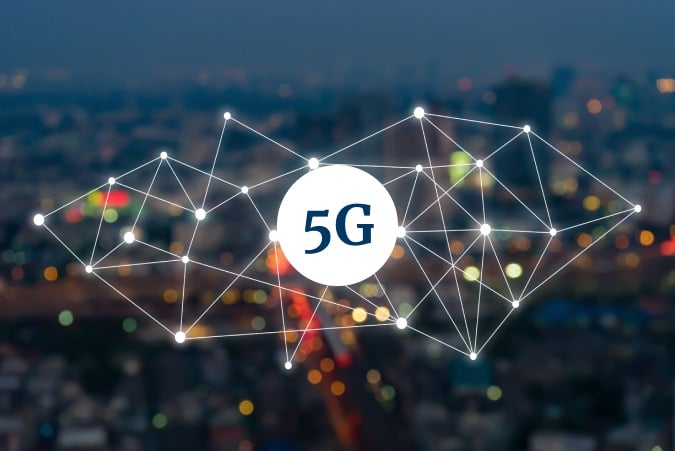By SYDNEY J. FREEDBERG JR.
 WASHINGTON: After a remarkably fast interagency review, the White House today announced a massive transfer of electromagnetic spectrum from military use to commercial 5G. It will be the “fastest transfer of federal spectrum to commercial use in history,” US Chief Technology Officer Michael Kratsios told reporters proudly this afternoon. But, Kratsios and Pentagon CIO Dana Deasy assured reporters ahead of the announcement, the rush won’t compromise military readiness or operations.
WASHINGTON: After a remarkably fast interagency review, the White House today announced a massive transfer of electromagnetic spectrum from military use to commercial 5G. It will be the “fastest transfer of federal spectrum to commercial use in history,” US Chief Technology Officer Michael Kratsios told reporters proudly this afternoon. But, Kratsios and Pentagon CIO Dana Deasy assured reporters ahead of the announcement, the rush won’t compromise military readiness or operations.
The 100 megahertz of spectrum runs from 3450 MHz to 3550, so-called mid-band frequencies prized by 5G developers because they allow longer-ranged transmissions than the millimeter-wave spectrum that makes up most of what’s been available in the US so far. Kratsios and other officials told reporters shortly before this afternoon’s announcement that the move would dramatically expand 5G access for all Americans – fulling a congressional mandate in the 2018 MOBILE NOW Act – and strengthen potential competitors to Chinese giant Huawei in the global market.
Currently, Deasy said, “the 3450-3550 mHZ band supports critical DoD radar operations, including high-powered defense radar systems on fixed, mobile, shipboard, and airborne platforms, [including] air defense, missile and gun fire control, counter mortar, bomb scoring [during training exercises], battlefield weapon locations, air traffic control, and range safety.”
That’s a wide range of military functions, many with life-or-death significance for either training safety or outright combat. Deasy and other officials didn’t detail how the Defense Department would work this massive transfer. Their remarks, however, suggested a mix of migrating military radars to other frequencies – a complex and costly process typically funded from a share of the FCC auction – and sharing frequencies with commercial users in specific times and places.
The White House formally made the request in April. Roughly 200 technical experts from all four armed services, the Office of Secretary of Defense, and the White House Office of Science & Technology Policy studied the problem for 15 weeks. The FCC, which has already endorsed the plan, will start auctioning the spectrum off in December 2021, Kratsios said, with commercial use beginning “as soon as mid-2022.”
That’s as fast as the transfer can possibly go through the FCC’s public rule-making process, officials said. Historically transferring spectrum takes six years or more. ““The timeline that we’re working with is absolutely unprecedented,” one senior administration official told reporters, “and I cannot underscore that enough.”
Many members of Congress want the Pentagon to transfer or share spectrum for commercial use, with the 2018 Act sponsoring a National Telecommunications & Information Administration (NTIA) study on how to transfer 255 MHz of spectrum to 5G and other broadband services by 2022. But others are pushing back, especially after the FCC’s controversial recent decision to transfer spectrum to Ligado that might adversely affect GPS navigation.
When today’s press call opened to questions, I asked how the Department of Defense can be confident it can transfer so much spectrum, so quickly, without disrupting training and operations?
While this specific review went quickly, “the DoD has been focused on mid-band spectrum sharing opportunities with FCC and NTIA for years,” a senior administration official replied. The NTIA study sponsored by the MOBILE NOW Act laid a lot of the groundwork for the military’s review, they said. So did the previous interagency work on the transfer of Citizens’ Band radio in the adjoining 3550 to 3650 MHz spectrum: The science and engineering concerns for that slice of spectrum, the official said, “were very similar what we’re going to have to do here.”
That previous work made it possible to jumpstart this transfer, the officials said. But a great deal of detail remains to be thrashed out.
“We will work with industry as part of this entire auction process to come up with …plans of operations as to how do we take that spectrum and share it where it’s basically made available for industry use,” the official said, “but where we have unique sites or unique requirements throughout the US… we will come up with an arrangement that allows us to share it during those particular operations.”
The 3450 to 3550 band was chosen in large part because the military could move out of it quickly without grave consequences, the official said: “The collective goal of both the White House and DOD was what spectrum could be made available for almost immediate use, [and] this particular range, from an operational standpoint was well suited for us to meet that goal.”
While the Pentagon, White House, and NTIA will keep looking for more spectrum to transfer, the official added, it’ll get harder: “As we go down lower down in the spectrum, the operational needs of the DoD and what has to be done to make that availability becomes much more complex.”
This transfer alone increases the amount of contiguous spectrum available for mid-band 5G in the US by 23 percent. “With this addition of 100 MHz,” Deasy said, “the US now has a continuous 530 megahertz of mid-band spectrum, from 3450 to 3980 MHz, to enable higher-capacity 5G networks.”
The 100 MHz, Kratsios said, “will be made available for contiguous coast to coast 5G deployment at full commercial power levels.”
5G is seen as vital not just for telecommunications but for self-driving cars and a host of other devices — the Internet of Things — that require constant low-latency, high-bandwidth data sharing to function.
Boosting 5G in the US, another official said, not only benefits domestic consumers but strengthens national security in the global strategic competition with China. (Huawei is banned from US networks, so the more 5G gets built in the US, the more Huawei’s Western competitors get business that the Chinese giant can’t compete for, shoring up their shaky position worldwide).
“All these things play into each other,” the official said. “This is what’s going to enable us to get really strong, large domestic systems built out that be able to have coverage into rural and suburban America, [but also] without domestic deployment, you’d don’t have the market share being supported for the trusted vendors that are Huawei’s competitors.”

No comments:
Post a Comment